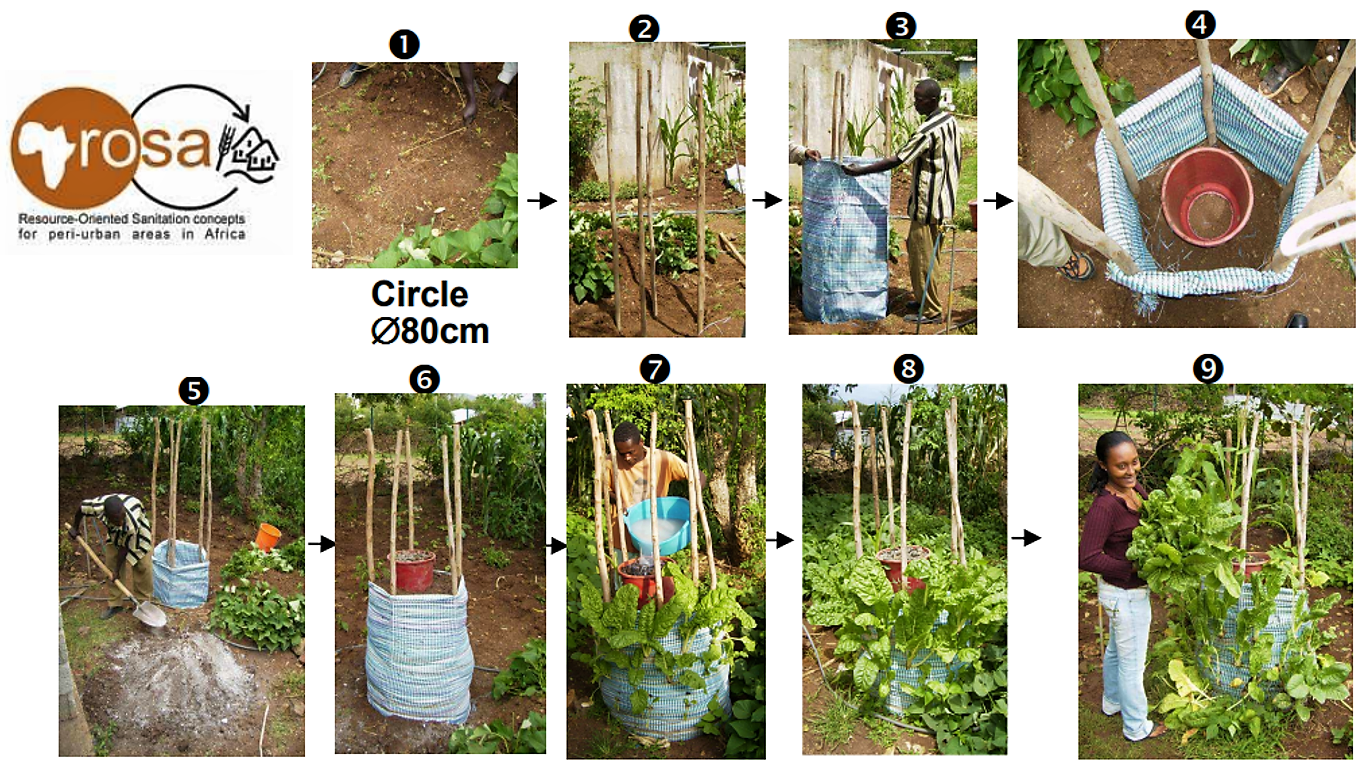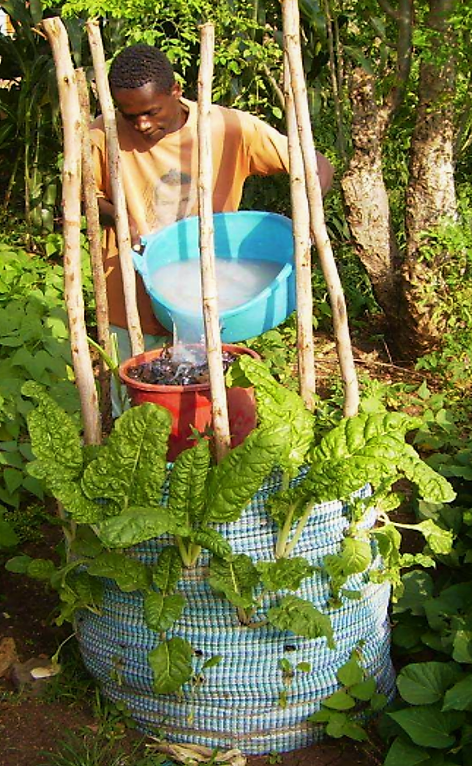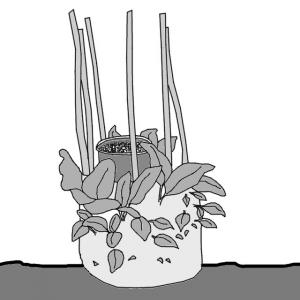A greywater tower is a circular bag, which is filled with soil, ash and/or compost mixture and a gravel column at the centre. It is used to treat and reuse greywater - water that has been used for bathing, washing clothes and utensils. Vegetables are planted in holes cut in the sides of the bag and each day the available greywater from a household is poured directly on the gravel column making grow the vegetables.
| In | Out |
|---|---|
Treated Water, Food Products |
Greywater (the wastewater from bath, laundry and kitchen) accounts for around 50 to 80% of the residential wastewater with manageable contamination levels. It therefore offers great potential for reuse in agriculture, particularly in areas where water is scarce. Greywater towers are low-cost solutions that allow for the reuse of the water and nutrient content in greywater and productively using it for gardening purposes.
Greywater towers are cylindrical and made out of simple plastic bags or clothes, reinforced with wooden poles, filled with a soil mix (soil, ash and/or compost/vermicompost) and anchored into the soil. Vegetables are grown in holes cut in the sides of the bag. Each day, the available greywater is poured into the bag. The soapy water contains nutrient on which vegetables can grow successfully. The soapy water can be cleared out of the system by pouring two buckets of clean water into the column once a week.
For the construction of a greywater tower, a circle has to be marked out on the ground with a diameter of around 80 cm. The bottom layer of the tower has to be dug out and the wooden side poles need to be firmly planted into the ground. A shade cloth will be wrapped around the poles and the resulting cylinder will be filled with gravel in the middle and the soil mix all around. The backfill has to be well mixed before applying it. A bucket with its bottom removed can be placed at the bottom in the middle of the tower to increase stability and improve the flow regime. Small stones should be packed in the bucket to increase weight. To prevent fast flow of the water through the bucket and to achieve even water distribution, small stones (provided they are evenly packed) should be used. Once the bucket is filled up with stones, it is backfilled with the soil mixture. Then, the bucket can be removed (and reused), leaving the stones in position. The soil should be humid but not too wet, when packing the tower. The soil should be evenly distributed as compacted water will not let water flow through. The procedure of placing the bucket, filling it with stones, backfill it and then remove the bucket has to be repeated for each soil layer until the top layer of the greywater tower (around 1 m in height).

Greywater towers are ideal for leafy crops such as spinach. Ideally the planting holes should not be one above the other but staggered diagonally, providing more space for root development. Different crops which use the soil in a complementary way should be grown to facilitate biological control of disease and pests. Tomatoes and onions can be planted on the top of the tower. Garlic and onions are also useful to prevent plant diseases and pests. If crops require trellises this can be provided by extending the vertical uprights and joining them with wire or string.
One of the main advantages of the method is that little labour for construction and little operation and maintenance is required. Once people have become familiar with the towers, they are easily maintained. The towers can be positioned right at the back door so that it is easy to pour the wastewater into the tower.
It is difficult to predict how much water is required, and the necessary experience will usually come over time. In the beginning it is recommended to apply around 20 L per day and fine-tune it according to the exact water demand. If water forms a puddle around the bottom of the tower, too much water is being applied. A possible answer to this problem would be to make a second tower.

Greywater towers provide a simple and low-cost method to treat and reuse greywater for gardening and food production and are particularly recommended in water-scarce areas.
In the peri-urban areas of many cities in developing countries, greywater is far too often discharged untreated on the soil or into ground and surface water sources. This results in bad smell and stagnant water, risk for malaria, diarrhoea and other waterborne diseases. The reuse of greywater directly by the household, which is continuously producing vegetables (in warm climates) is a simple and sustainable solution for greywater treatment offering a solution not only for a cleaner and healthier environment but also for improving the household food security and livelihood situation.
Tower gardens
The paper gives a brief overview on the topics of greywater and greywater gardens including a short manual on how to construct a greywater tower as well as information on suitable crops.
IWRM (2008): Tower gardens. South Africa: Department of Water Affairs and Forestry’s Integrated Water Resources Management (IWRM) URL [Accessed: 19.05.2010]Greywater use in peri-urban households in Kitgum, Uganda. Kampala, Uganda
This study was undertaken within the ROSA project (Resource oriented Sanitation concepts in peri‐urban areas in Africa) in order to understand greywater characteristics and to demonstrate a low cost reuse option involving direct application of untreated greywater to small so called “greywater towers” at household level in peri‐urban settlements in Kitgum Town Council.
KULABAKO, R. ; KINOBE, J. ; MUJUNGA, J. ; OLWENYI, S. ; SLEYTR, K. (2009): Greywater use in peri-urban households in Kitgum, Uganda. Kampala, Uganda. In: Sustainable Sanitation Practice: Volume 1 , 16-24 . URL [Accessed: 19.05.2010]Arba Minch town ROSA project. Project Booklet. Resource Oriented Sanitation concepts for peri-urban areas in Africa
The ROSA project has been working on promoting resource oriented sanitation systems that focus on implementation of simple, cost effective and affordable sanitation units and carrying out research on these pilot units. This booklet attempts to provide practical information about the activities carried out by Arba Minch town ROSA project including information on the implementation and testing of greywater towers.
ROSA (2006): Arba Minch town ROSA project. Project Booklet. Resource Oriented Sanitation concepts for peri-urban areas in Africa. Ethiopia: Arba Minch University URL [Accessed: 09.05.2019]Greywater Use for Agricultural Irrigation in Urban and Peri-Urban Areas
Presentation on the use of greywater for agricultural irrigation in the South African context with special focus on a study comparing the irrigation of plants with nutrient solution, grey water and tap water.
SALUKAZANA, L. JACKSON, S. RODDA, N. SMITH, M. GOUNDEN, T. MACLEOD N. BUCKLEY, C. (n.y): Greywater Use for Agricultural Irrigation in Urban and Peri-Urban Areas. Kwazulu-Natal: University of Kwazulu-NatalGreywater Tower, The Arba Minch town ROSA project experience. Poster for the 34th WEDC International Conference, Addis Ababa, Ethiopia, 2009
Poster for the 34th WEDC conference with several pictures that illustrate the step-by-step construction of greywater towers.
SHEWA, W. A. (2009): Greywater Tower, The Arba Minch town ROSA project experience. Poster for the 34th WEDC International Conference, Addis Ababa, Ethiopia, 2009. Arba Minch, Ethiopia: Arba Minch Town ROSA project Office PDFGreywater Tower, Arba Minch, Ethiopia. Draft
Greywater towers were selected as one of the methods that can be adopted to treat and safely reuse greywater for Arba Minch town and eight such units were constructed. Awareness about the unit has been raised in the community of Arba Minch and promising demand has been created.
SHEWA, W.A. GELETA, B.G. (2009): Greywater Tower, Arba Minch, Ethiopia. Draft. (= SuSanA - Case Studies ). Eschborn: Sustainable Sanitation Alliance (SuSanA) URL [Accessed: 09.05.2019]Integrated Water Resources Management (IWRM)
The paper is divided in two main parts: The first part puts forward a strong case for applying IWRM globally and defines the IWRM concept and process. The second part provides additional advice and guidance on how IWRM could be implemented in different conditions.
GWP (2000): Integrated Water Resources Management (IWRM). (= TEC Background Papers , 4 ). Stockholm: Global Water PartnershipTower gardens
The paper gives a brief overview on the topics of greywater and greywater gardens including a short manual on how to construct a greywater tower as well as information on suitable crops.
IWRM (2008): Tower gardens. South Africa: Department of Water Affairs and Forestry’s Integrated Water Resources Management (IWRM) URL [Accessed: 19.05.2010]Greywater Management in Low and Middle-Income Countries, Review of Different Treatment Systems for Households or Neighbourhoods
This report compiles international experience in greywater management on household and neighbourhood level in low and middle-income countries. The documented systems, which vary significantly in terms of complexity, performance and costs, range from simple systems for single-house applications (e.g. local infiltration or garden irrigation) to rather complex treatment trains for neighbourhoods (e.g. series of vertical and horizontal-flow planted soil filters).
MOREL, A. DIENER, S. (2006): Greywater Management in Low and Middle-Income Countries, Review of Different Treatment Systems for Households or Neighbourhoods. (= SANDEC Report No. 14/06 ). Duebendorf: Swiss Federal Institute of Aquatic Science (EAWAG), Department of Water and Sanitation in Developing Countries (SANDEC) URL [Accessed: 27.05.2019]Introduction to Greywater Management
The report gives a comprehensive description of the main components in successful greywater management. Examples as well as recommendations are given for designing and dimensioning treatment systems.
RIDDERSTOLPE, P. (2004): Introduction to Greywater Management. (= EcoSanRes Publication Series, Report 2004-4 ). Stockholm: Stockholm Environment Institute, EcoSanRes Programme URL [Accessed: 19.05.2010]Arba Minch town ROSA project. Project Booklet. Resource Oriented Sanitation concepts for peri-urban areas in Africa
The ROSA project has been working on promoting resource oriented sanitation systems that focus on implementation of simple, cost effective and affordable sanitation units and carrying out research on these pilot units. This booklet attempts to provide practical information about the activities carried out by Arba Minch town ROSA project including information on the implementation and testing of greywater towers.
ROSA (2006): Arba Minch town ROSA project. Project Booklet. Resource Oriented Sanitation concepts for peri-urban areas in Africa. Ethiopia: Arba Minch University URL [Accessed: 09.05.2019]Greywater Use for Agricultural Irrigation in Urban and Peri-Urban Areas
Presentation on the use of greywater for agricultural irrigation in the South African context with special focus on a study comparing the irrigation of plants with nutrient solution, grey water and tap water.
SALUKAZANA, L. JACKSON, S. RODDA, N. SMITH, M. GOUNDEN, T. MACLEOD N. BUCKLEY, C. (n.y): Greywater Use for Agricultural Irrigation in Urban and Peri-Urban Areas. Kwazulu-Natal: University of Kwazulu-NatalGuidelines for the safe use of wastewater excreta and greywater. Volume III. Wastewater and Excreta Use in Aquaculture
Volume III of the Guidelines for the Safe Use of Wastewater, Excreta and Greywater deals with wastewater and excreta use in aquaculture and describes the present state of knowledge regarding the impact of wastewater-fed aquaculture on the health of producers, product consumers and local communities. It assesses the associated health risks and provides an integrated preventive management framework.
WHO (2006): Guidelines for the safe use of wastewater excreta and greywater. Volume III. Wastewater and Excreta Use in Aquaculture. Geneva: World Health Organisation URL [Accessed: 08.05.2019]Wastewater Treatment and Use in Agriculture
This Irrigation and Drainage Paper is intended to provide guidance to national planners and decision-makers, agricultural and municipal managers, field engineers and scientists, health and agricultural field workers, wastewater treatment plant operators and farmers. Consequently, it covers a broad range of relevant material, some in considerable depth but some more superficially. It is meant to encourage the collection, treatment and use of wastewater in agriculture in a safe manner, with maximum advantage taken of this resource. Informal, unplanned and unorganized wastewater use is not recommended, nor is it considered adviseable from the health or agricultural points of view.
PESCOD, M.B. (1992): Wastewater Treatment and Use in Agriculture. (= FAO Irrigation and Drainage Paper , 47 ). Rome: Food and Agriculture Organisation of the United Nations (FAO) URL [Accessed: 25.10.2011]Productive Sanitation and the Link to Food Security
This factsheet provides information on the link between sanitation and agriculture as well as related implications on health, economy and environment. It shows examples of treating and using treated excreta and wastewater in a productive way and describes the potential for urban agriculture and resource recovery in rural areas. Institutional and legal aspects, business opportunities and how to manage associated health risks are also discussed
GENSCH, R. DAGERSKOG, L. WINKLER, M. VEENHUIZEN, R. van DRECHSEL, P. (2011): Productive Sanitation and the Link to Food Security. Sustainable Sanitation Alliance (SuSanA) URL [Accessed: 09.05.2019]Development of Guidance for Sustainable Irrigation Use of Greywater In Gardens and Small-Scale Agriculture in South Africa
There are presently no formal guidelines for the use of greywater in South Africa. This paper presents the rationale and framework of a guidance document for the sustainable use of greywater to irrigate gardens and small-scale agriculture in South Africa, developed under the auspices of the Water Research Commission.
RODDA, N. CARDEN, K. ARMITAGE, N. PLESSIS, H.M. du (2011): Development of Guidance for Sustainable Irrigation Use of Greywater In Gardens and Small-Scale Agriculture in South Africa. Pretoria: Water Research Commission (WRC) URL [Accessed: 07.05.2019]Greywater use in peri-urban households in Kitgum, Uganda. Kampala, Uganda
This study was undertaken within the ROSA project (Resource oriented Sanitation concepts in peri‐urban areas in Africa) in order to understand greywater characteristics and to demonstrate a low cost reuse option involving direct application of untreated greywater to small so called “greywater towers” at household level in peri‐urban settlements in Kitgum Town Council.
KULABAKO, R. ; KINOBE, J. ; MUJUNGA, J. ; OLWENYI, S. ; SLEYTR, K. (2009): Greywater use in peri-urban households in Kitgum, Uganda. Kampala, Uganda. In: Sustainable Sanitation Practice: Volume 1 , 16-24 . URL [Accessed: 19.05.2010]A garden in a Sack: Experiences in Kibera, Nairobi
Article in the RUAF Urban Agriculture Magazine on gardening activities in the Kibera slum, Nairobi, Kenya
PASCAL, P. ; MWENDE, E. (2009): A garden in a Sack: Experiences in Kibera, Nairobi. In: Urban Agriculture Magazine: Volume 21 , 38-40. URL [Accessed: 22.05.2012]Re-use of Greywater for Agricultural Irrigation
Study on the use of greywater for agricultural irrigation in the South African context with special focus on comparing the irrigation of plants with nutrient solution, greywater and tap water.
SALUKAZANA, L. JACKSON, S. RODDA, N. SMITH, M. GOUNDEN, T. MACLEOD, N. BUCKLEY, C. (n.y): Re-use of Greywater for Agricultural Irrigation. Kwazulu-Natal: University of Kwazulu-Natal URL [Accessed: 08.05.2019]Greywater Tower, Arba Minch, Ethiopia. Draft
Greywater towers were selected as one of the methods that can be adopted to treat and safely reuse greywater for Arba Minch town and eight such units were constructed. Awareness about the unit has been raised in the community of Arba Minch and promising demand has been created.
SHEWA, W.A. GELETA, B.G. (2009): Greywater Tower, Arba Minch, Ethiopia. Draft. (= SuSanA - Case Studies ). Eschborn: Sustainable Sanitation Alliance (SuSanA) URL [Accessed: 09.05.2019]Tower gardens
The paper gives a brief overview on the topics of greywater and greywater gardens including a short manual on how to construct a greywater tower as well as information on suitable crops.
IWRM (2008): Tower gardens. South Africa: Department of Water Affairs and Forestry’s Integrated Water Resources Management (IWRM) URL [Accessed: 19.05.2010]Greywater Tower, The Arba Minch town ROSA project experience. Poster for the 34th WEDC International Conference, Addis Ababa, Ethiopia, 2009
Poster for the 34th WEDC conference with several pictures that illustrate the step-by-step construction of greywater towers.
SHEWA, W. A. (2009): Greywater Tower, The Arba Minch town ROSA project experience. Poster for the 34th WEDC International Conference, Addis Ababa, Ethiopia, 2009. Arba Minch, Ethiopia: Arba Minch Town ROSA project Office PDFIntroduction to Greywater Management. FactSheet
This factsheet provides information and experiences on simple greywater treatments including sorption, infiltration, vertical soil filters and also trickling filters.
ECOSANRES (2008): Introduction to Greywater Management. FactSheet. (= EcoSanRes Factsheet , 8 ). Stockholm: Stockholm Environment Institute EcoSanRes Programme URL [Accessed: 22.04.2010]


